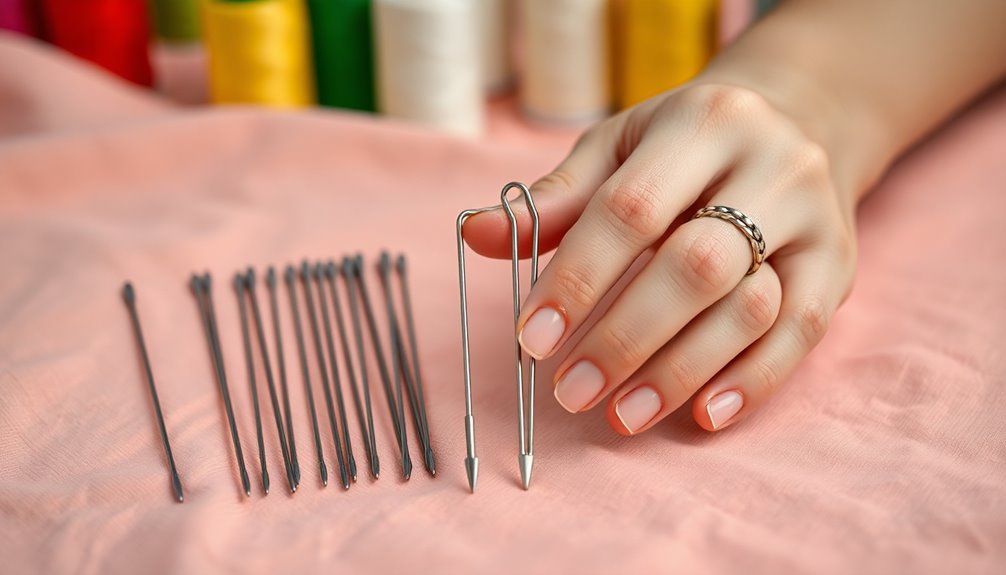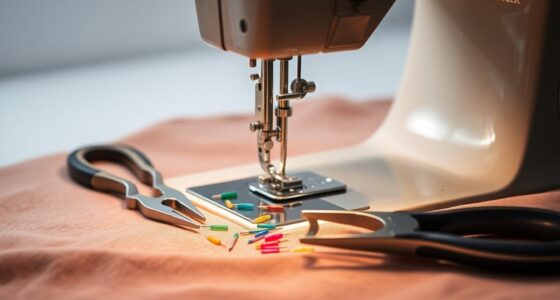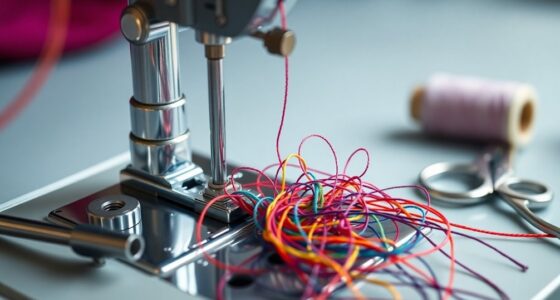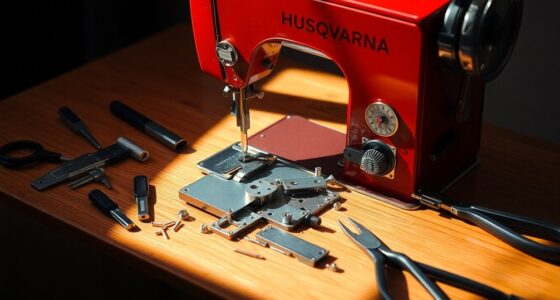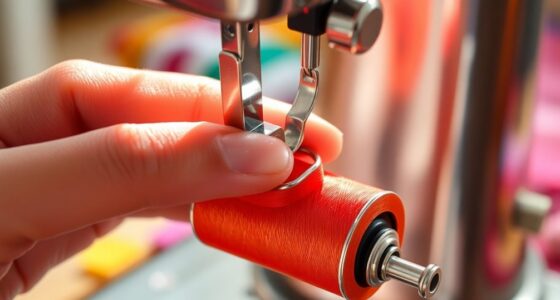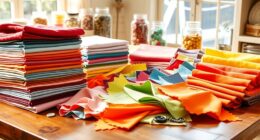When choosing a sewing machine needle for cotton, you'll want to select the right size for your fabric's weight. For lightweight cotton, use a 70/10 needle, and for medium weights, an 80/12 is perfect. Thicker cotton requires a 90/14 or even a 100/16 jeans needle. It's crucial to match your needle to the cotton and thread to avoid issues like skipped stitches. Stay tuned to discover even more tips for perfecting your sewing projects!
Key Takeaways
- For general cotton sewing, use an 80/12 universal needle for versatility across different cotton weights.
- Lightweight cotton requires a 70/10 needle to protect delicate fibers from damage.
- Medium to heavy cotton fabrics are best sewn with a 90/14 needle for optimal results.
- Thicker cottons, like those using 12 wt thread, should be sewn with a 100/16 jeans or topstitch needle.
- Always test needle compatibility on scrap fabric to ensure clean stitches and prevent issues like skipped stitches.
Understanding Needle Sizes for Cotton

When it comes to sewing cotton, understanding needle sizes is key to achieving the finest results. The most common needle sizes for cotton fabrics are 70/10, 80/12, and 90/14.
For general sewing projects, the 80/12 universal needle is your best bet, as it strikes a balance between versatility and performance. If you're working with lightweight cotton, opt for the 70/10 needle to protect those delicate fibers.
For medium to heavy cotton fabrics, the 90/14 needle provides durability and quality stitching. When quilting, using either the 80/12 or 90/14 needle helps you navigate multiple layers seamlessly.
Always choose your needle size based on the specific cotton fabric's weave to guarantee ideal results in your sewing endeavors.
Recommended Needle Types for Different Cotton Weights
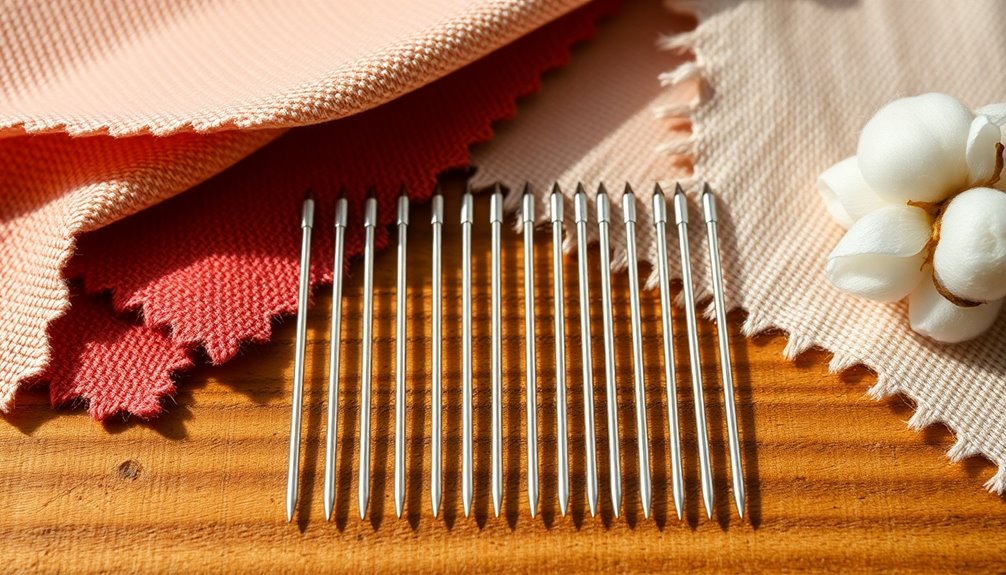
Selecting the right needle type for different cotton weights can greatly impact your sewing experience.
For thicker cotton fabrics, like those made with 12 wt cotton thread, you'll want to use a 100/16 jeans or topstitch needle. This guarantees proper stitching and peak thread performance.
When working with 30 wt cotton thread, a 90/14 topstitch needle is ideal for achieving great stitch quality and reducing the risk of needle breakage.
For standard cotton fabric, universal needles in sizes 70/10 to 90/14 offer versatility across various cotton weights.
Optimal Needle Sizes for 12 Wt and 30 Wt Cotton
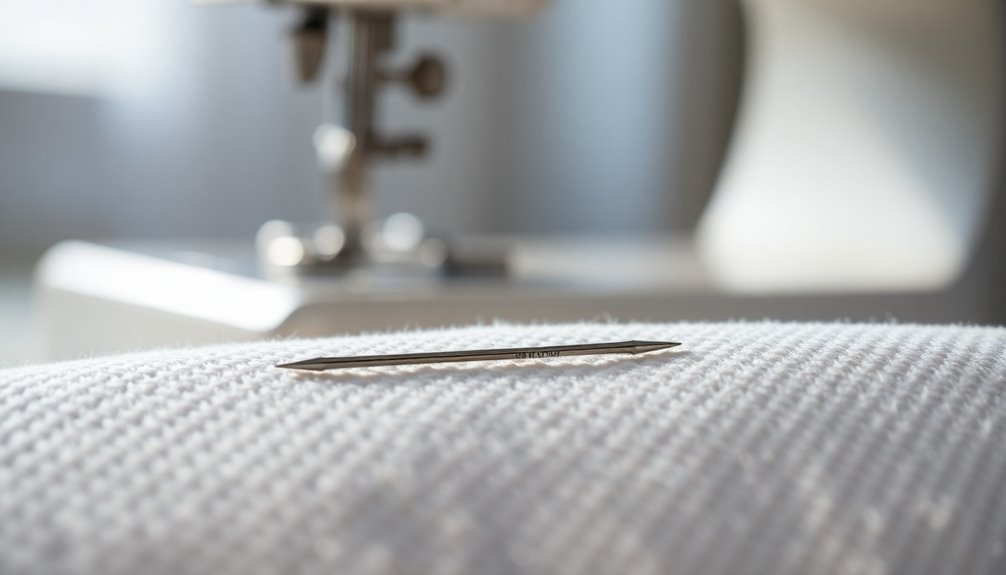
Choosing the right needle size is vital for working with 12 wt and 30 wt cotton threads. For 12 wt cotton thread, you should use at least a 100/16 jeans or topstitch needle. This guarantees proper stitching and thread performance.
When you're using 30 wt cotton thread, a 90/14 topstitch needle is ideal for achieving the best stitch quality without risking needle breakage.
Remember, the thickness and density of the fabric might require you to upsize the needle for consistent stitching. Proper needle selection is imperative to avoid damaging both your fabric and thread.
Always match the weight of the thread with the appropriate needle sizes to get the desired stitch effects in your projects.
Importance of Needle Selection in Sewing Performance
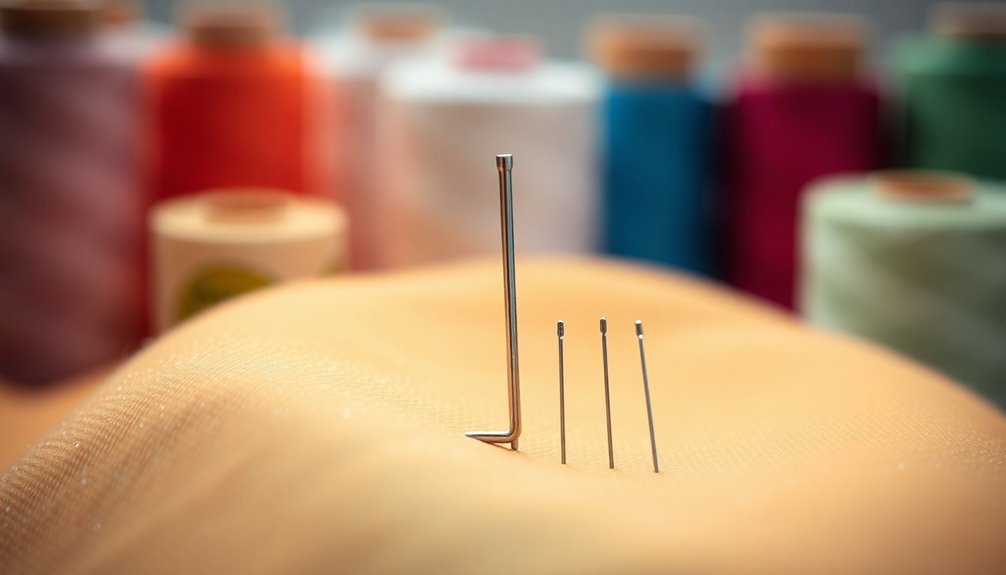
The right needle can make all the difference in your sewing performance, ensuring clean stitches and protecting your fabric from damage.
Selecting the correct needle size, like 70/10 or 80/12 for cotton, is essential for achieving those perfect stitches. Using a needle that's too thick can create large holes, while a needle that's too thin can lead to skipped stitches or breakage.
Sharp needles or specialty needles maintain cotton fiber integrity, promoting smoother sewing. Additionally, don't forget to regularly change your needle every 6-10 hours to keep performance ideal.
Proper needle selection not only enhances your sewing experience but also leads to successful results, so always test your needle size on scrap fabric before starting your project.
Testing Your Needle Choice on Scrap Fabric
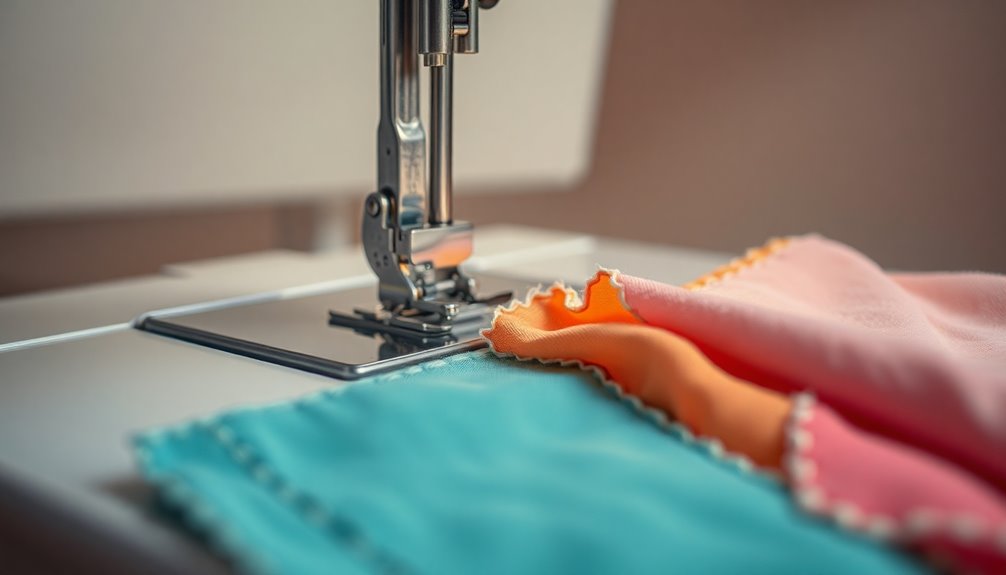
Before you start your project, it's essential to test your needle choice on a scrap piece of the same cotton fabric.
This helps you spot any issues like skipped stitches or puckering, so you can adjust the needle size if necessary.
Documenting your results will make future projects smoother and more efficient.
Importance of Testing
Testing your needle choice on scrap fabric is essential to achieving the best results in your sewing projects. By doing this, you can identify the right needle size that matches the thickness of the fabric you're working with, ensuring ideal stitch quality.
Using a needle that's too thick may damage your fabric, while a needle that's too fine can lead to skipped stitches. It's also important to test with the same thread you'll use for your project since different thread weights may require adjustments in needle size.
Consistently testing on scrap pieces can help you avoid potential problems during sewing, saving you both time and materials in the long run.
Adjusting Needle Size
Finding the right needle size for your cotton fabric is key to achieving smooth, professional-looking stitches. Always test your needle choice on a scrap piece of the same fabric to ascertain compatibility.
For most cottons, start with a size 80/12 or 90/14 needle. If you're working with thicker cottons or multiple layers, you might need to adjust to a larger size, such as 100/16. For lightweight cottons, consider a smaller needle like 70/10.
While testing, pay close attention to the stitching quality—skipped stitches or fabric damage indicate that you should reassess your needle choice.
Finally, if using cotton thread, universal needles are great, but specialized quilting or topstitch needles can improve performance on thicker threads.
Signs That It's Time to Change Your Needle
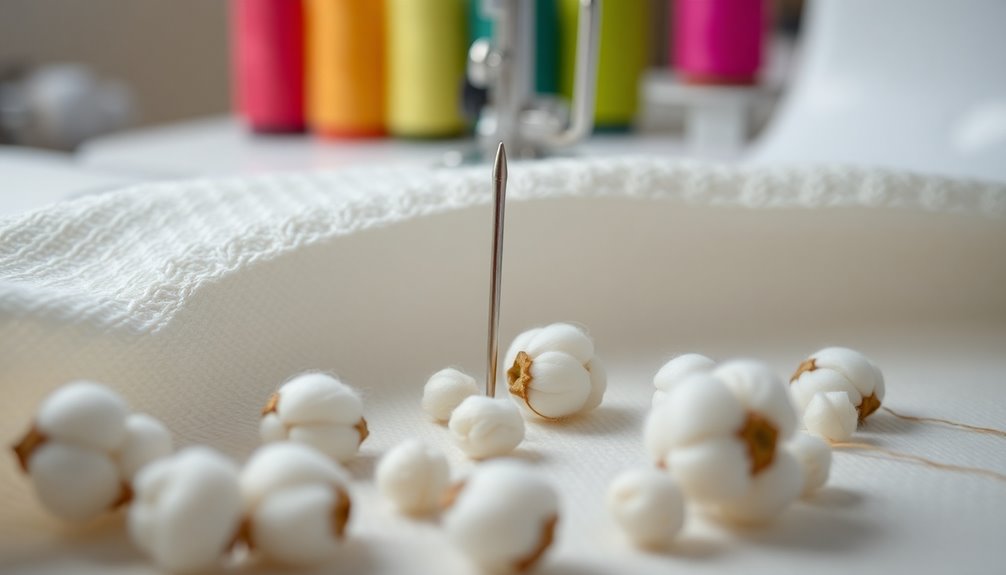
You might notice that your sewing projects aren't going as smoothly as they should, which could be a sign it's time to change your needle.
Look out for skipped stitches, unusual noises from your machine, or fabric snags—these are indicators of a dull needle.
Keeping an eye on these symptoms can help you maintain the quality of your work and protect your fabric.
Dull Needle Symptoms
A sewing machine needle that's lost its sharpness can wreak havoc on your projects. You might notice increased noise from your machine, signaling that it's time to change the needle.
A dull needle struggles to penetrate fabric, leading to potential fabric damage like snags or holes. If you're feeling the tip and it doesn't have that sharp point you expect, it's a clear sign the needle's lost its edge.
Regularly checking the condition of your needle can save you from these issues—ideally, you should change the needle after about 6-10 hours of sewing.
Stay proactive, and don't let a dull needle ruin your creations!
Skipped Stitches Occurrence
Dull needles can lead to more than just noise and fabric damage; they often cause skipped stitches, which can disrupt your sewing flow.
If you notice irregular stitching patterns, it's time to evaluate your sewing needle. Skipped stitches frequently occur when the needle is damaged or dull, so consider changing it after 6-10 hours of use.
For cotton fabrics, using the right size and type is essential; a universal needle size 70/10 or 80/12 is recommended.
While skipped stitches can also indicate threading issues or tension problems, replacing the needle should be your first step.
Regularly check for signs of wear to maintain the quality of your projects and avoid unnecessary fabric damage.
Unusual Noise Detection
Unusual noises from your sewing machine, like grinding or clattering, often signal that it's time to change your needle.
If you hear increased vibration or rattling, it may mean the needle is either not properly seated or worn out. Skipped stitches can also accompany these unusual sounds, indicating a dull needle or one that's not suitable for your fabric.
Pay attention to any significant rise in noise levels while sewing; this might suggest friction caused by a bent needle or the wrong type for your project.
Regularly monitoring for odd sounds helps prevent further damage to your machine and enhances your overall sewing experience by ensuring timely needle changes.
Don't ignore these signs; your sewing machine will thank you!
Common Mistakes to Avoid When Choosing Needles
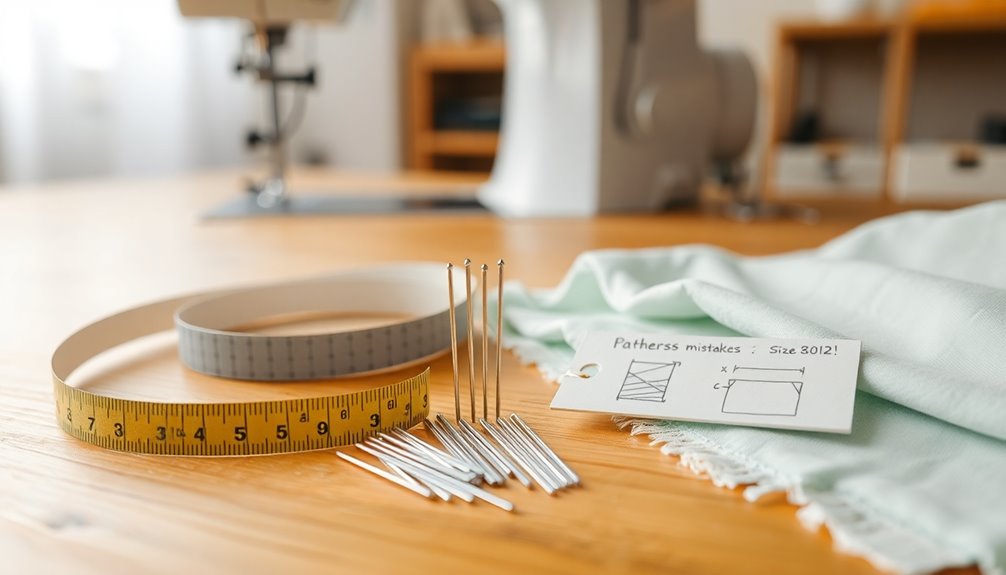
When selecting a sewing machine needle for cotton, it's easy to make mistakes that can affect your project's outcome. One common mistake is using needles that are too thick for lightweight fabrics, which can create unsightly holes. A size 70/10 or 80/12 is usually best for light to medium cottons.
Many sewists overlook the needle type; while universal needles are suitable for most cotton, a sharp needle is essential for finer cottons. Forgetting to change your needle after several hours of sewing can lead to issues like skipped stitches.
Also, using a ballpoint needle on woven cotton can damage seams. Always test your needle on a scrap piece first to avoid these common mistakes and guarantee a successful project.
Additional Resources for Needle Selection and Usage
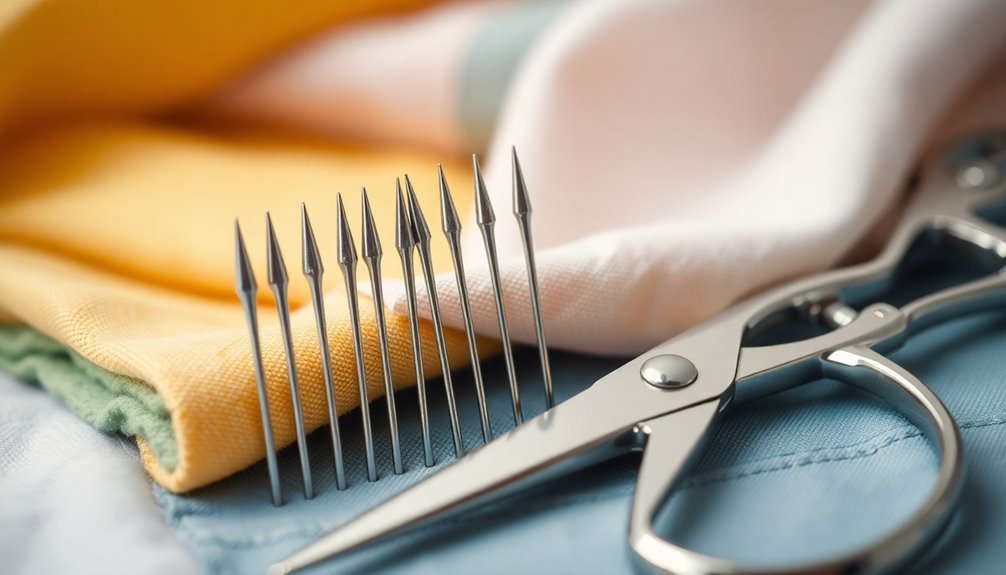
Selecting the right needle for your cotton projects can greatly impact your sewing experience, so it's helpful to have reliable resources at your fingertips. Websites like Schmetzneedles.com offer detailed information on needle size and types, guiding you in your needle selection for cotton.
For ideal results, you typically want a needle size between 70/10 and 90/14, depending on fabric weight. Remember, using the correct sewing machine needles—universal for general cotton or sharp for tightly woven cotton—ensures smoother stitching. Additionally, it’s essential to consider the bobbin size for Pfaff machines, as using the wrong size can lead to tension issues and uneven stitching. Always check your machine’s specifications to ensure you have the appropriate bobbin installed. Furthermore, regular maintenance and needle changes will keep your sewing projects running smoothly and efficiently.
Before you start, test needle compatibility on scrap cotton to avoid issues like skipped stitches.
Finally, keep up with regular needle changes after about 6-10 hours of sewing to improve your projects and prolong your machine's life.
Frequently Asked Questions
What Size Sewing Machine Needle Is Best for Cotton?
When you're sewing with cotton, the best needle size usually depends on the fabric weight. For general cotton, you'll find that an 80/12 needle works perfectly.
If you're quilting, consider using a size 70/10 or 80/12 for precise stitches. For heavier cotton, like denim, you should opt for a size 90/14 or larger.
Always match your needle size with the thread weight to guarantee smooth sewing and avoid breakage.
What Is the Best All-Purpose Sewing Machine Needle Size?
You'd think picking a sewing machine needle size is as easy as pie, but it's more like piecing a puzzle!
For all-purpose use, you'll want to grab a size 80/12 or 90/14. These sizes tackle most medium-weight fabrics effortlessly.
If you're sewing something lighter, like cotton lawn, opt for a 70/10 needle.
And remember, regularly swapping out your needles keeps your sewing smooth and your projects looking sharp.
Happy sewing!
What Is a 100/16 Sewing Machine Needle Used For?
A 100/16 sewing machine needle's great for heavyweight fabrics like denim and canvas.
You'll find it helps you easily penetrate thick materials, making it perfect for projects that require durability.
When you need to use 12 wt cotton threads, this needle guarantees proper stitching and performance.
Plus, its thick shaft reduces the risk of breakage, allowing for smooth sewing through multiple layers while delivering strong, visible stitches for topstitching applications.
What Are 90-14 Needles Used For?
You'll find that 90/14 needles are perfect for sewing medium-weight cotton fabrics. They strike a great balance between strength and size, making them ideal for quilting, especially when piecing together multiple layers.
You can use them with various cotton blends like cotton sateen and poplin, ensuring smooth stitching. Just remember to pair them with compatible threads, and change them after about 6-10 hours of sewing to keep your stitches looking their best.
Conclusion
When you choose the right sewing machine needle for cotton, you guarantee smooth seams and stellar sewing success. Remember, selecting the suitable size and type can greatly impact your project's performance. Don't hesitate to experiment with different needles on scrap fabric, and always stay vigilant for signs that it's time for a change. By avoiding common mistakes and utilizing available resources, you'll master the art of needle selection and elevate your sewing skills to new heights.
